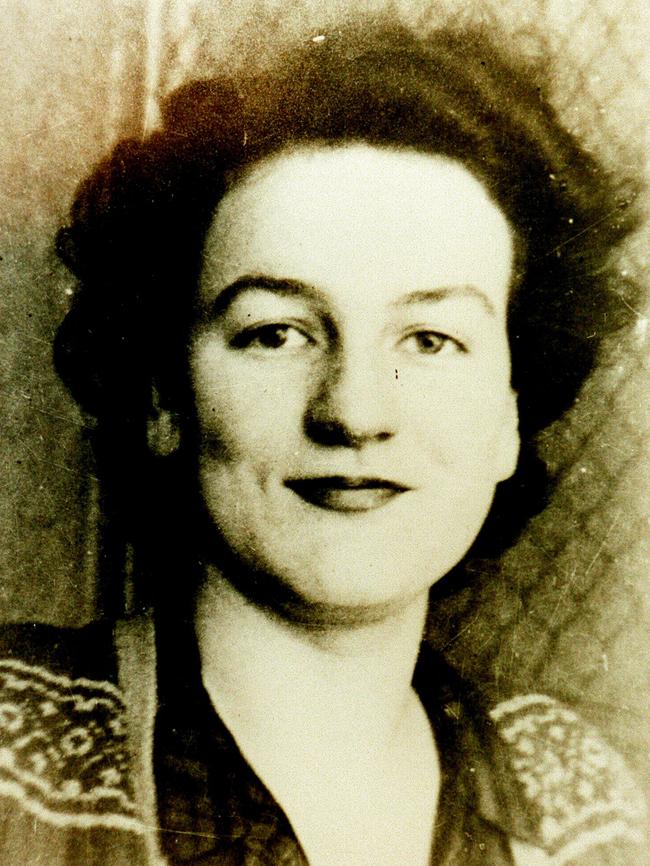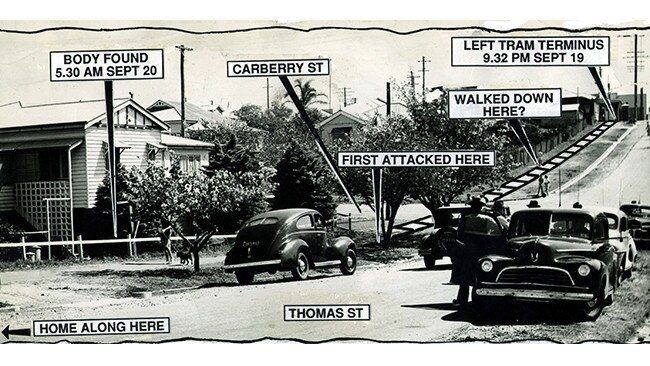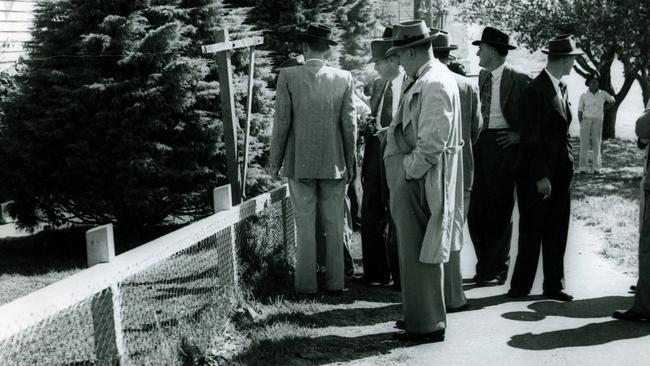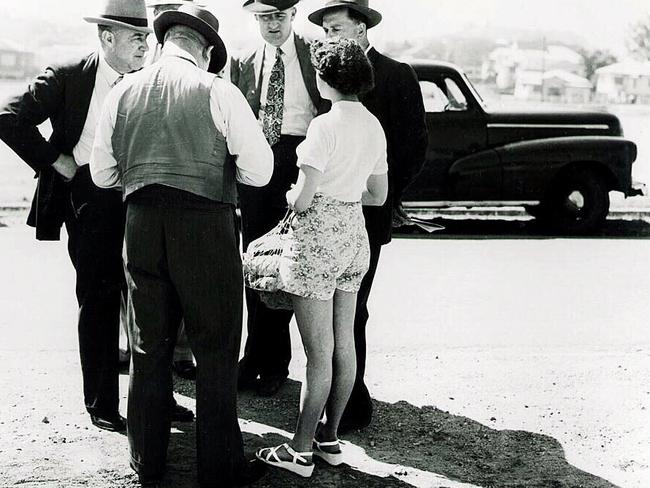AUSTRALIA’S third-largest city can pinpoint the day it lost its innocence. When the dark shadow of evil darkened the door of every household. When one innocent woman’s name came to signify the evil that lurked in the shadows.
Friday, September 19, 1952. Betty Shanks.
Pretty, friendly and seemingly without an enemy in the world, 22-year-old Betty had just stepped off a tram on Days Rd in the Brisbane suburb of Grange, and was walking the 300m to her home on Montpelier St on a fine, moon-less spring night when she was strangled and beaten to death and her body dumped in a stranger’s garden.
Several neighbours later reported hearing screams, but nobody bothered to investigate.
The crime sent shockwaves across a city still regarded as a sleepy town where people left windows open when they went out to work and slept with doors unlocked.
The crime, discovered by an off-duty police officer the next morning, launched Queensland’s biggest-ever murder investigation.

Today, almost 70 years later, and despite numerous confessions, suspects and even a $50,000 reward, police are no closer to solving the case. It’s likely Betty’s killer is dead anyway.
If the attacker was sexually motivated, he was interrupted or scared off. Betty was a virgin and there were no signs of a rape attempt.
Suspects have also been dismissed using more modern investigative methods such as DNA analysis.
Focused on her career, Betty was not married and as far as her friends and family knew, did not have a boyfriend. Theories linking her death to the work of a jilted lover have also been explored, but much like every other line of inquiry over the decades, they have all come up empty.
Seven men confessed to the crime. Each confession was proved false. Several books have been written about the killing. The house where her body was found is included on crime tours of the city.
Unlike so many other murder victims, Betty Shanks has never been forgotten.

Betty Shanks graduated in Psychology from the University of Queensland in 1950. She took a job as a trainee personnel officer with the Commonwealth Department of the Interior, working from an office in Ann Street, in the CBD.
As part of her job, Betty attended night classes after work on Wednesdays and Fridays. On Friday 19 September 1952, she did a day’s work, attended night school, travelled home by tram and arrived at The Grange terminus at 9.32pm.
The timing after that suggests that she met an acquaintance at the terminus and appears to have walked with him down Thomas St.
At about 9.39 or 9.40pm, about eight minutes after getting off the tram, at least seven people heard two distinct female screams. But when some of these people went to their windows to investigate, they could see nothing and went back inside.
When Betty’s battered body was found early the next day, she was lying on grass in the backyard of a residence on the corner of Thomas and Carberry streets, owned by a Mrs Hill. Betty had been attacked on the footpath of Thomas St in the shadow cast by some bauhinia trees and then pushed over, or thrown over, the cyclone wire fence of the Hills’ residence before being brutally bashed to death.
From start to finish the attack took about 12 minutes. By 9.53pm that night Betty was dead.
Several clues were found at the scene, including hand prints on the fence that may have been able to help identify the killer. But the most telling clue was found during the autopsy: an unusual patterned abrasion on Betty’s forehead that could have been caused by a soldier’s canvas gaiter or webbing belt and led police to believe the murderer might have been a serviceman.

But that line of investigation - like all others - led nowhere. Seven men confessed but were discounted as cranks. Of more interest to police were three people who author Ken Blanch described in his 2007 book, Who Killed Betty Shanks? as “a trio of shadowy figures”.
One was seen by witnesses lurking around the bus terminus just before Betty’s tram arrived; another was a man with blood on his face and clothing who hailed a cab at Newmarket, 3km from the crime scene, at 10.40pm on the night of the murder. The third was Dr Donald Ashley Carter, a GP from Ipswich who committed suicide two days after Betty’s murder. Despite rumours that he had met Betty at university, investigators could find no link between them.
Another suspect was locksmith Eric Sterry. Author Ted Duhs makes a compelling argument in I Know Who Killed Betty Shanks (2014) that Sterry was delusional and thought he was in a relationship with Shanks and killed her after she rebuffed him. Duhs based his theory on conversations with Sterry’s daughter Desche Birtles, who had made the same claim to police.
Police discounted Sterry as a suspect.
Another theory, put forward by author Lyle Reed in his 2016 book The Thomas St Affair, was that Betty was knocked down by a policeman on a motorcycle. She was badly injured but the cop did not seek help, instead dumping her in the backyard of the Hills house and later returning to finish her off by strangulation.
And there was the neighbour everyone seemed to have overlooked.
Former detective Abe Duncan firmly believed the killer was most likely James Coats. Ken Blanch, in his book, agreed.
It was to Coats’s house, two doors away from the murder scene, that off-duty policeman Alex Stewart ran when he discovered Betty Shanks’s body at first light on September 20, 1952. It was Coats’s phone that he used to call the police.
Duncan never had the chance to interview Coats about the murder - he was put in charge of a small team and despatched to door-knock houses between the murder scene and Lutwyche - but he had pored over the inquest transcripts and was troubled by discrepancies in Coats’s testimony.

Unlike others - including his next-door neighbour Constable Stewart - who heard Betty Shanks moaning about 9.40pm, Coats swore that he heard the same noise, but an hour later. He also said he had never spoken to Betty Shanks, although they had lived 250m from each other her entire life.
These claims were known to have concerned officers in charge of the investigation at the time. They troubled Abe Duncan, too.
“Something just doesn’t seem right,” Duncan told The Courier Mail in 2012. “I was a detective sergeant at the time but I was never given details about the wider investigation. Had I been, I would have certainly suggested that a more thorough check be made of Jim Coats.
“I would like to know whether a thorough investigation was carried out at his house. There are so many little things that can mean something.
“Did they search the refrigerator? When were his shoes last used? Was he in his pyjamas when he heard these noises? All these sorts of things, and they apparently weren’t undertaken at the time.
“That’s where I keep going back to, the possibilities that were living near her home. See, sometimes with these things the solution can be much closer to home than where you start looking.
“I just can’t stop thinking about it.”
A month after that interview, Abe Duncan rang Ken Blanch. He’d been thinking a lot about the Betty Shanks case, he said. He wasn’t feeling too well, but he wanted to talk. Ken said they would get together when he felt better.
Five days later, Abe Duncan died.
The murder of Betty Shanks remains the oldest murder case still open in Queensland.

Top cop’s stern words in cold case search
Police have issued cautionary words to a team of private investigators who are searching for the remains of two girls who disappeared from an AFL match in 1973.
Fresh hope decades after girls abducted
There has been a major development in the search for two girls who were taken from their families in broad daylight more than 50 years ago.